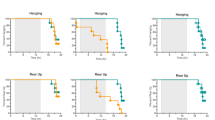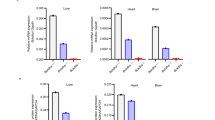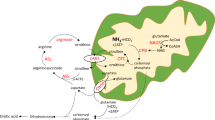Abstract
Citrullinemia is an autosomal recessive disorder caused by the deficiency of argininosuccinate synthetase (AS). It is characterized by elevated levels of blood citrulline and ammonia, which often results in hyperammonemic coma and early neonatal death in affected children. We have explored the use of adenoviral vectors as a treatment modality in a murine model of citrullinemia, the Ass mouse. The Ass mouse has no endogenous AS activity due to a targeted interruption of the AS gene. Homozygous mutant animals develop high levels of blood citrulline, become hyperammonemic, and die within 24–48 h after birth. We demonstrated that the neonatal crisis in Ass mice can be ameliorated by the injection of a recombinant adenovirus carrying human AS cDNA (Ad.CMVhAS) within hours after birth. The average life span of the virus-treated animals was extended from 30 ± 9.5 h to 16.1 ± 1.6 days. A second viral infusion 14 days after the first dose further prolonged the life span to an average of 36.2 ± 7.0 days, and to 40.7 ± 3.3 days with a concurrent daily injection of arginine and sodium benzoate. Significantly increased liver AS activity (47.3 ± 7.9% of normal) was detected 24 h after viral infusion, which reached peak levels (80–90% of normal) at day 7 and decreased to about 20% of normal within 2–3 weeks after viral infusion. Southern blot analysis of liver DNA revealed a transduction efficiency of about one viral genome per hepatocyte 7 days after viral infusion and a gradual decrease of viral genome per cell parallel to the loss of liver AS activity. Plasma glutamine levels were partially normalized in virus-treated animals and were completely normalized in animals receiving Ad.CMVhAS concurrently with alternative pathway therapy. Plasma arginine levels were also partially normalized. Together, these results demonstrated that the recombinant adenovirus was capable of conferring AS activity in the liver of the recipient animals within 24 h, and the neonatal crisis of hyperammonemia could be averted by acute treatment with the AS containing adenovirus.
This is a preview of subscription content, access via your institution
Access options
Subscribe to this journal
Receive 12 print issues and online access
$259.00 per year
only $21.58 per issue
Buy this article
- Purchase on Springer Link
- Instant access to full article PDF
Prices may be subject to local taxes which are calculated during checkout





Similar content being viewed by others
References
Brusilow S, Horwich A . Urea cycle enzyme. In: Scriver C et al (eds) The Metabolic and Molecular Bases of Inherited Disease McGraw-Hill: New York 1995 pp . 1187–1232
Nagata N, Matsuda I, Oyanagi K . Estimated frequency of urea cycle enzymophthies in Japan (letter) Am J Med Genet 1991 39: 228–229
Msall M et al. Neurologic outcome in children with inborn errors of urea synthesis New Engl J Med 1984 310: 1500–1505
Harper P et al. Citrullinemia as a cause of neurological disease in neonatal Friesian calves Aust Vet J 1986 63: 378–379
Dennis J et al. Molecular definition of bovine argininosuccinate synthetase deficiency Proc Natl Acad Sci USA 1989 86: 7947–7951
Lee B et al. Hepatocyte gene therapy in a large animal: a neonatal bovine model of citrullinemia Proc Natl Acad Sci USA 1999 96: 3981–3986
Patejunas G et al. Generation of a mouse model for citrullinemia by targeted disruption of the argininosuccinate synthetase gene Som Cell Mol Genet 1994 20: 55–60
Patejunas G et al. Evaluation of gene therapy for citrullinaemia using murine and bovine models J Inher Metab Dis 1998 1 (Suppl. 1): 138–150
Yang Y et al. Cellular and humoral immune responses to viral antigens create barriers to lung-directed gene therapy with recombinant adenoviruses J Virol 1995 69: 2004–2015
Yang Y, Greenough K, Wilson JM . Transient immune blockade prevents formation of neutralizing antibody to recombinant adenovirus and allows repeated gene transfer to mouse liver Gene Therapy 1996 3: 412–420
Ye X et al. Adenovirus-mediated in vivo gene transfer rapidly protects ornithine transcarbamylase-deficient mice from an ammonium challenge Pediatr Res 1997 41: 527–534
Featherston W, Rogers Q, Freedland R . Relative importance of kidney and liver in synthesis of arginine by the rat Am J Physiol 1973 224: 127–129
Jan D et al. Definitive cure of hyperammonemia by liver transplantation in urea cycle defects: report of three cases Transplant Proc 1994 26: 188
Feillet F, Leonard J . Alternative pathway therapy for urea cycle disorders J Inher Metab Dis 1998 21 (Suppl. 1): 101–111
Robinson M, Djali S, Buchhalter J . Inhibition of glutamate uptake with L-trans-pyrrolidine-2,4-dicarboxylate potentiates glutamate toxicity in primary hippocampal cultures J Neurochem 1993 61: 2099–2103
O'Brien W . Isolation and characteization of argininosuccinate synthetase from human liver Biochemistry 1979 18: 5353–5356
Acknowledgements
We wish to thank Dr Bonnie LaFleur for performing statistical analysis. This work was supported by the NICHD PO1-HD32649 (to MLB and XY).
Author information
Authors and Affiliations
Rights and permissions
About this article
Cite this article
Ye, X., Whiteman, B., Jerebtsova, M. et al. Correction of argininosuccinate synthetase (AS) deficiency in a murine model of citrullinemia with recombinant adenovirus carrying human AS cDNA. Gene Ther 7, 1777–1782 (2000). https://doi.org/10.1038/sj.gt.3301303
Received:
Accepted:
Published:
Issue Date:
DOI: https://doi.org/10.1038/sj.gt.3301303



